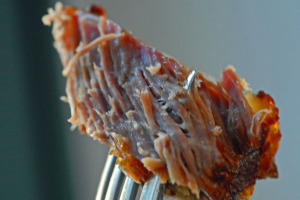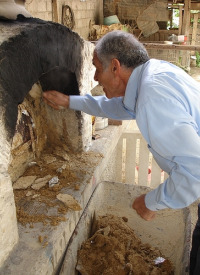Kleftiko: Cyprus' Answer to Barbecue
The island's signature dish takes an aged goat and cooks it for hours with wine, vegetables, and carob chips.

Photo by Aglaia Kremezi
From Atlantic Food contributor Aglaia Kremezi :
When my dear friend Seth Rosenbaum first described kleftiko to me, I remembered it as a wonderful, but long-forgotten, Cypriot family dish: Slow roasted goat meat over carob cuttings! It turns out that one can still taste this delicacy at a few taverns on the island. For those who can't build the special oven though, here is my alternative recipe . But first read all about it:
MFK Fisher famously taught the British public How to Cook a Wolf , but would she have known what to do with an aged goat? A far cry from delicate spring lamb, the sinewy goat requires its own special preparation, so much so that in Cyprus it appears in one dish and one dish only: kleftiko, literally the thief's meal.
What inspired the name? In short, the criminal mind, though as with most things in the Hellenic world, one person's vigilante is another's patriot. It is said that the dish is named after the kleftes , the 19th-century guerillas who fought the Ottomans. In an effort to keep their hideouts secret, the kleftes developed a method of cooking that produced no smoke, literally burrowing fire-pits into the ground in which they could bake, not grill, their meat, thereby protecting them from Ottoman detection. The kleftes cooked for survival of one kind, but modern Cypriot cuisine demands a different standard of kleftiko if it is going to compete against not Ottomans but rival tavernas. An old goat is neither wolf nor lamb nor spring chicken, and to turn the tough meat into a buttery version of its namesake has become a source of great national pride. As Cypriots will fondly, if not religiously, insist, "You can't make kleftiko outside of Cyprus!"
An instance of hot-blooded nationalism, or a sincere warning worth heeding? Perhaps a bit of both. Either way, it fires the imagination, and I find myself constantly recalling, if imperfectly, the strong aroma of the dish, the memory of a taste somehow richer and deeper in flavor, and yet far subtler and less overpowering, than oven-roast lamb. The thief's meal will always be my first after landing in Larnaca.
In theory, you could probably reproduce kleftiko on foreign soil, but you would need to be prepared for a strikingly high level of commitment. To begin with, you would need to find yourself the animal. An old goat, at least three years of age, is not exactly standard fare in the meat aisle, not even at your most committed local butcher.

Photo by Aglaia Kremezi
Assuming you can find the katsiki , it should then be butchered into large pieces, still on the bone, and seasoned sparingly. By this I mean that the goat should be left a relative "virgin"--virgin only insofar as it is handled so little before being placed in the oven--I should hope though that the poor, old, "virgin" goat, as described, did not go through life entirely chaste. The goat should have nothing more than salt and pepper sprinkled onto its flesh, and is never enhanced by elaborate marinades or brines.
As you search for your animal, you would be well advised to start the minor task of constructing the classic Cypriot clay fournos or oven , in which your meat will bake from anywhere between 2 and 12 hours. It resembles a wood-burning pizza oven, with incredibly thick walls in a semi-circular, domed shape, but with a smaller opening. The function of the fournos, rather than a traditional oven or smoker, becomes important depending on precisely the type of kleftiko you want to produce. The distinction is marked, your choices two and two alone: ofton or ofton tis teratsias . Is your goal to concentrate Inferno-like heat, or to trap luscious smokiness? Do you desire buttery richness, or the slight firmness of a smoked goat rib?
With ofton, the more common preparation, tavernas will place the meat, dusted with salt and submerged in water, in terra cotta pots, well sealed in order to produce a Dutch-oven effect, in preparation for high-temperature baking. This method will produce excellent, buttery kleftiko, with the meat falling away from the bone into a stew of its own rendered fat and skin. But the more adventurous chef takes a different path in search of a remarkably different end product. He instead produces a dish known as ofton tis teratsias, "cooked in the carob tree oven," a method for making kleftiko that originates from the Karpasia peninsula, and can still be found in a few devoted tavernas on the island.
NEXT :
PAGES :
Once the oven is white-hot, the chef sweeps the charcoal and ash from the center of the fournos to the side walls, making way for the centerpiece, which bakes for anywhere from 4 to 10 hours, or more in some cases. The principle behind rendering the sinews and collagen of the meat into the dish's hallmark velvety texture combines both indirect, scorching heat, as well as small amounts of smoke penetration that creep in through the seals on the terra cotta pots. Once ready, the meat falls from bone to plate to mouth, with little time in transit.
For ofton tis teratsias, however, the fire pit instead acts as more of a "cold" smoker than a radiant heat room--too much heat and the meat will fall apart, with no dish to hold it together. How much is too much? The most precise answer I was able to get from locals invariably ran something like this: "you should be able to touch your hand to the inner wall of the oven for just three seconds." Then, apparently, the temperature is just right. The tis teratsias chef then takes a fresh, wet batch of carob wood with stems and leaves attached and lays them in the center of the oven, forming a bed onto which the meat is placed. The wood must be wet to prevent it from catching fire, and also to encourage smoking. Because the meat has no proper baking dish as in standard ofton, chefs generally use the ribs of the goat in order to maintain the structural integrity of the meat in the oven, and also because the rib meat, even at a lower temperature, will cook more quickly than the thicker cuts of old, tough goat, which are reserved for the standard kleftiko. As in traditional barbecue, the combination of fresh wood and charcoal produces a smoking effect, but in this case the wood makes no contact with the charcoal embers, resulting in subtler, less pervasive smoke penetration.

Photo by Maria Symeonidou Georgiadou
The next and perhaps most difficult step in producing kleftiko, either ofton or ofton tis teratsias, is a necessary patience, the self-control not to check the meat during its roast. If one were to open the ofton oven prematurely, precious heat would be lost. If one were to try to sneak a look at the ofton tis teratsias too soon, the concentrated smoking effect, along with the moist, low heat atmosphere, would literally evaporate with the wind. It is no wonder then that the secret to great kleftiko, as I have been told many times, lies in the quality of the seal on the oven's small door. By carefully fastening the thick metal door, either with clay or a dough and flour paste, the oven becomes a steaming chamber, sealing in either heat or smoke, depending on the method of choice. Do the Cypriots have some kind of special formula for sealing their fournos, distinct from other clay oven traditions? Not so far as I can tell. Rather, I am tempted to understand their focus on "quality of seal" as synonymous with a kind of chef's intuitive judgment, and knowing the right time to break the seal on the cooking chamber.
Many of the same ideas lie behind the great barbecue we know from the South in the United States--a total control of heat and moisture, except that in these instances the Cypriots perform the task at a range of temperatures, ideally without sacrificing texture or juiciness. After 12 hours (or more) of preparation, from oven lighting to the actual roasting, the fork-tender meat or succulent ribs are traditionally served with potatoes, sometimes braised in the fats and juices given off by the goat, collected in the terra cotta pans. The potatoes from Cyprus, already of superior quality, become incredibly luscious, if not to say a bit heavy, saturated with what certainly deserves the culinary distinction of goat jus .
PAGES :